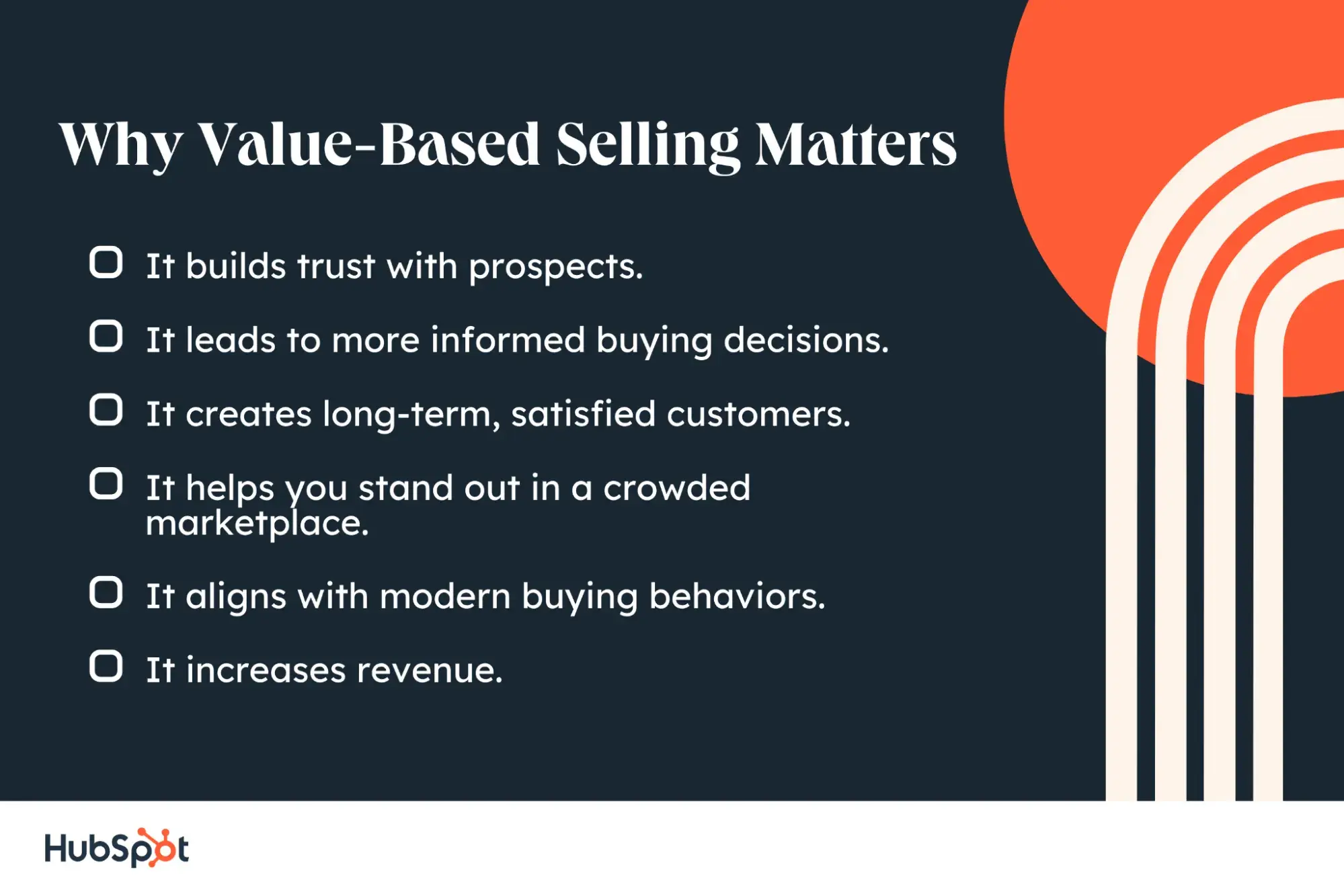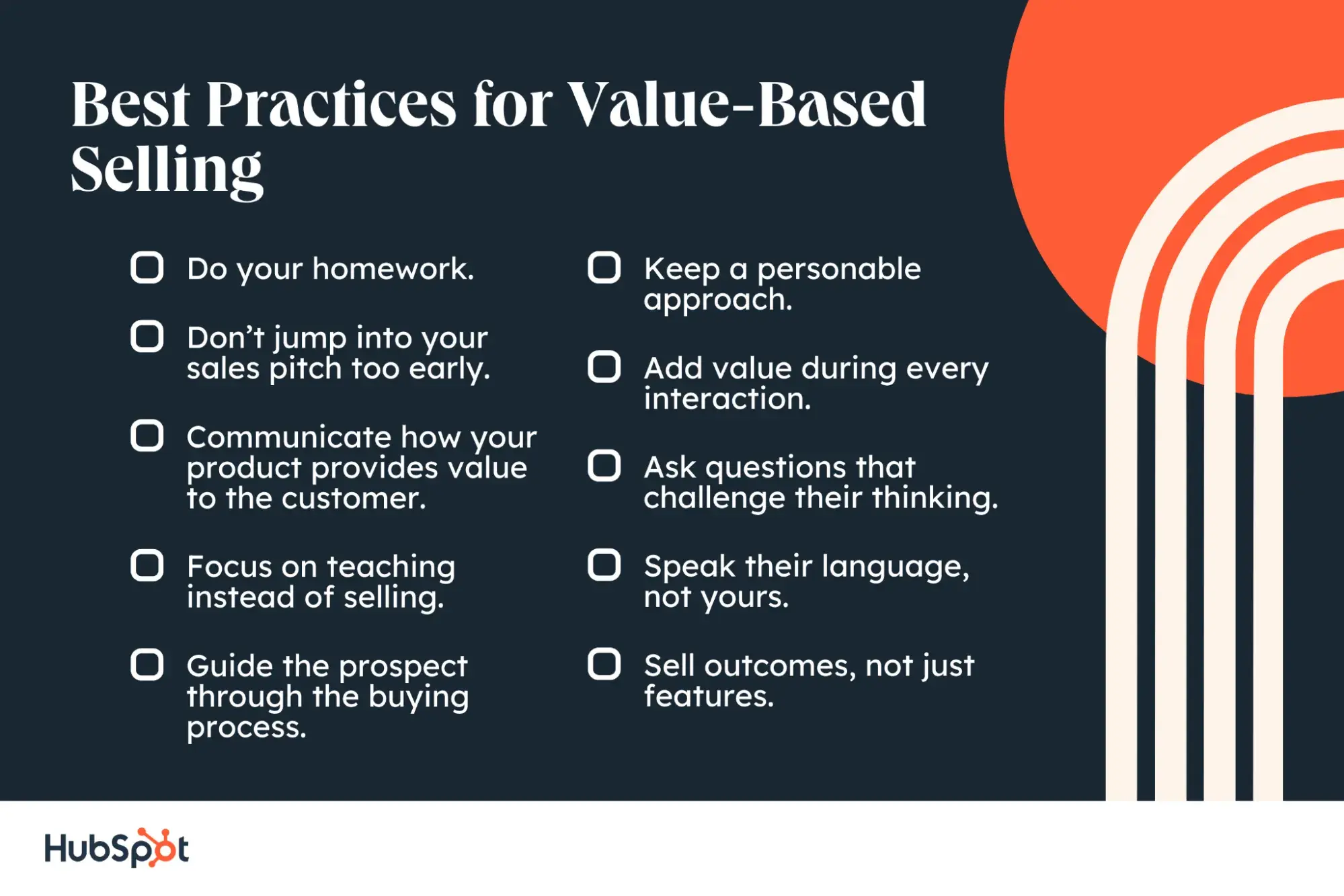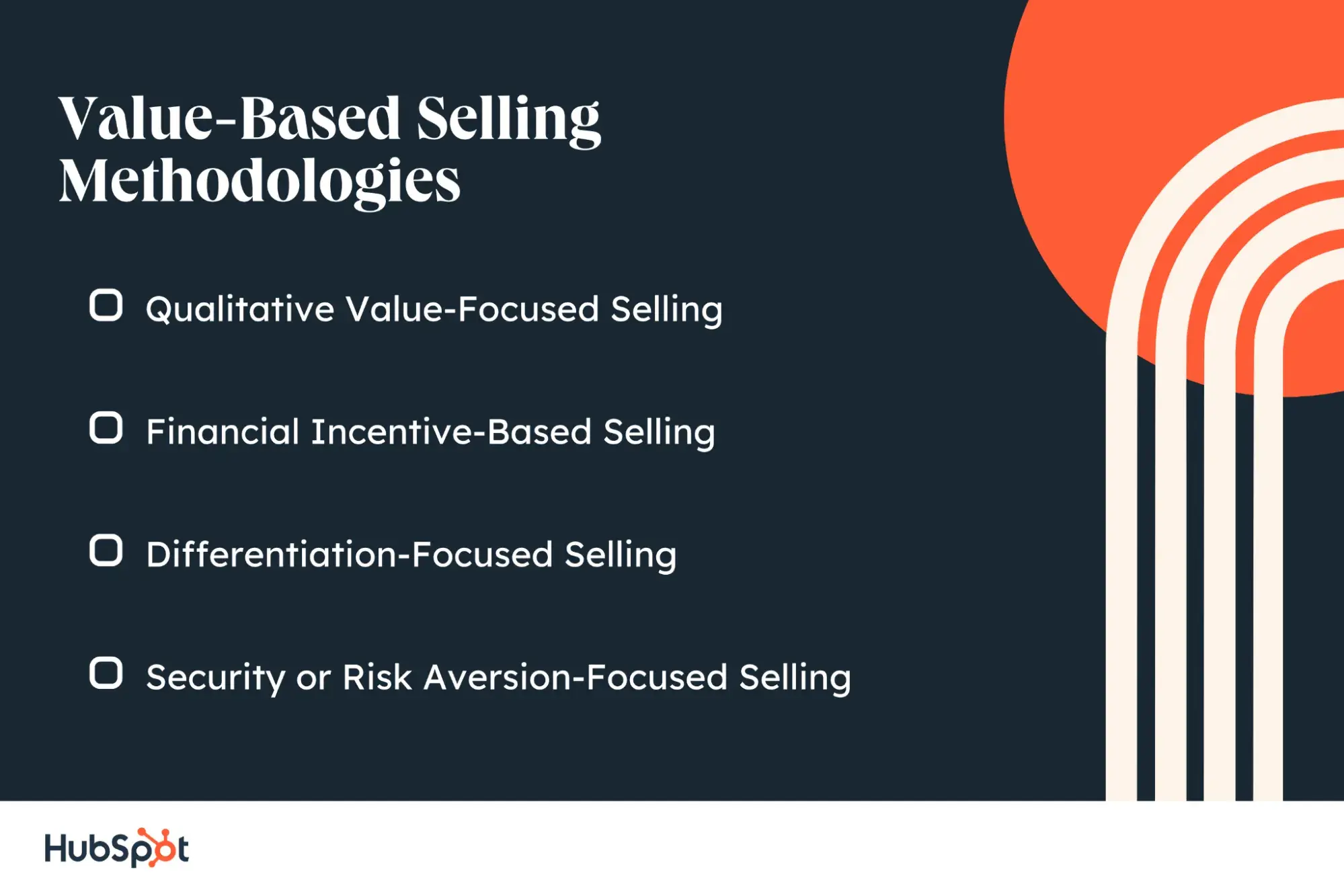Table of Contents
- What is value-based selling?
- A Value-Based Selling Framework
- Why Value-Based Selling Matters
- Best Practices for Value-Based Selling
- Value-Based Selling Methodologies
- Value-Based Selling Examples
What is value-based selling?
Value-based selling is an approach that focuses on benefitting the customer throughout the sales process. Sales reps focus on taking a consultative approach to provide value to the customer so the sales decision is made based on the potential value the product can provide.
In essence, value-based selling moves us from a mindset of “What can I sell?” to “How can I solve my client’s problem?” This shift fosters trust, deepens client relationships, and ultimately leads to sustainable business growth.
Pro tip: “The best salespeople today are those who can articulate the pain their prospects are experiencing,” says Callum Laing, founder of the Veblen Director Programme and a partner at Unity Group.
“The better you can capture their frustration, the better you can position your product as the solution. Customers want to be heard. Value-based selling means asking great questions and truly listening. If you’re not the best solution, be willing to walk away.”
A Value-Based Selling Framework
Understanding why buyers make purchasing decisions is the foundation of successful selling.
To move forward in the buying process, customers need confidence in three key areas: emotional connection, logical comparison, and trust in outcomes. These align with three core factors of the value-based selling framework: resonate, differentiate, and substantiate.
Resonate
Buyers must want and need what you’re selling, and your offering should align with their goals, challenges, and aspirations. By understanding these, you will know if your product is a good fit for them and how to pitch it so it hits homes.
Among the top six reasons prospects back out of deals, 31% of salespeople surveyed in our State of Sales report said it was because prospects weren’t convinced the offering was worth the price, and another 28% said prospects weren’t convinced it was right for them. With a value-based selling approach, salespeople could close more of these deals by focusing on the value of their offering.
Here’s how Christina Brady, CEO of Luster, explains value-based selling: “The first thing to keep in mind with value-based selling is that it’s not about what you, as the salesperson, perceive the value of your product or service to be. It’s about understanding what’s valuable in a solution for the customer and then determining if your product is a fit for their needs.”
This means asking insightful questions, actively listening, and mapping their priorities to your solution’s benefits — rather than just pitching features.
Differentiate
Your offering must stand out from other available options. Buyers evaluate differentiation by comparing features, pricing, brand perception, and overall fit for their specific needs. What makes your product or service unique? Why should they choose you over competitors?
This means first creating an offering that stands out from the competition, and then promoting and explaining what makes it unique. A thorough market research can help you understand the competitive landscape, gaps in competitors’ offerings, and market sentiment. Knowing what’s already out there will allow you to position your brand better.
In other words, to differentiate your product or service, you need to have a clearly defined unique selling proposition that your sales reps can articulate to prospects.
Substantiate
Finally, your offering must prove it will deliver on its promises. Can you provide evidence, case studies, or testimonials that back up your claims? If you can’t prove the value you offer, prospects have nothing other than your words.
With 77% of B2B customers doing their own research before speaking with sales, I think it’s more important than ever to care for the reputation of your brand. Customers — both satisfied and not — will make their opinions of and experiences with your brand known on social media, review sites, and in conversations with their friends.
While you can’t control what other people say, you can amplify the positive feedback, share the hard numbers that represent success, and provide success stories to prospects. All of these will substantiate your value claims.
I think Mike Schultz, president of RAIN Group, sums it up well. He explains that a strong value proposition should address all three areas. “When your value proposition successfully covers these three areas, you convince buyers that they need your solution, you’re the best option, and they believe you’ll achieve results,” he says.
This buyer-focused approach is the foundation of value-based selling.
Pro tip: With Sales Hub, your team can focus on the highest-value prospects — using data-driven insights to personalize outreach and maximize results.
Why Value-Based Selling Matters
In my opinion, value-based selling is the only way to sell. By putting the customer and their needs first, customers will trust you and the value your product or service offers them. Moreover, their relationship with your business won’t end after they make a purchase — they will stick around if they find value and recommend you to others.
In other words, value-based selling ensures both your customers and your company win. Check out how below.

- It builds trust with prospects. By prioritizing the customer's needs over your sales targets, you establish yourself as a trusted advisor rather than just another salesperson. In fact, I learned that top-performing sellers are 60% more likely to excel at presenting the overall value persuasively and 63% more likely to excel at making and communicating strong ROI and financial cases for buyers.
- It leads to more informed buying decisions. When you educate your prospects about their challenges and potential solutions, they’re better equipped to make decisions that truly benefit their business.
- It creates long-term, satisfied customers. Customers who feel their needs have been understood and met are more likely to become loyal, repeat buyers and brand advocates.
- It helps you stand out in a crowded marketplace. In a world where prospects are bombarded with sales messages, I’ve found a value-based approach can set you apart from competitors who are still using aggressive, product-centric tactics.
- It aligns with modern buying behaviors. Today’s buyers are more informed and self-directed than ever. I like how value-based selling respects this by providing relevant, helpful information throughout the buying process. According to RAIN Group, buyers report that a seller’s “focus on the value they can deliver” is the #1 most influential factor in their purchase decision — with 96% finding it influential.
- It increases revenue. 90% of sales teams that use a value-based approach report year-over-year revenue growth, compared to 72% of sales teams that don’t.
Best Practices for Value-Based Selling
Most sales pitches fall flat because they focus on the product instead of the prospect. The best salespeople don’t just sell — they solve problems. To master value-based selling, I spoke with experts who’ve been in the trenches. If you want to close more deals, start with these best practices.

1. Do your homework.
Remember, the goal of value-based selling is to close the sale by prioritizing your prospect’s needs. However, you can’t prioritize your prospect’s needs if you don’t know what those needs are. Always do your homework to understand your contact — usually well before hopping on a sales call.
When researching a prospect, aim to understand their company and industry, background, and current pain points. By understanding these pieces of information, you’ll have a solid grasp of how to serve them best.
Here is some information I recommend researching when you prepare for your call.
Their Current Role and Previous Job Experience
I’ve found a simple LinkedIn search can help you learn about your prospect’s career history. Are they new to their current role? If so, they might still be ramping up and could benefit from learning from you.
Is this their first time making this type of purchasing decision, or have they been in similar roles? If they have experience in this area, they may be more interested in expediting the process so you can better serve them with efficiency.
Common Connections
If you have a common connection with a prospect, that can help you build trust with them faster. Additionally, the contact could help provide key insights into the prospect’s pain points and how you could provide value to them.
Content Shared on Social Media
If your prospect has a public X or Facebook profile, checking out what content they have recently shared or engaged with can give you an idea as to what is currently important to them.
Their Company’s Website, Press, and Social Media Pages
This will tell you whether their company has undergone any recent leadership changes, is currently releasing a new product, or has been in the news.
Their Contact Listing in Your CRM
Before hopping on the phone with your prospect, I definitely recommend checking out their profile in your CRM. This will tell you if and when any of your colleagues have engaged with them and what content from your company they have opened or engaged with.
Additionally, performing a simple Google search for their company’s competitors will give you a great deal of information about their industry landscape.
Pro tip: Remember, as Dale Shephard, founder of TrinityHawk, wisely points out, “Asking unprepared questions that you should know will not garner trust, and your prospect will close up.” The more you know going in, the more value you can provide from the very first interaction.
Need a structured approach to organize your preparation and value-based selling strategy? Our free Sales Plan Template helps you document your company positioning, target market analysis, prospecting strategy, and sales cadence. It has everything you need to align your team around delivering maximum value to customers.
2. Don’t jump into your sales pitch too early.
I know it’s tempting to launch into your carefully crafted sales pitch as soon as you get your prospect on the line. Resist this urge! Instead, give your prospect space to explain their current situation and what they’re looking for.
“The first thing you learn as a salesperson is not to data dump. If you’re going in blind and start listing everything your company does, you will exhaust the prospect’s attention span before you get to the part they care about,” says Jeff Walling, co-owner of ABM Equipment.
By listening first, you’ll gain invaluable insights that will help you tailor your approach and position your product or service as the ideal solution to their specific needs.
“Best practice is always to start by asking the client what their needs are, think about what pains you can solve, and then only talk about those. That’s why, in person-to-person sales, it can be said that all good selling is value-based selling,” Walling adds.
3. Communicate how your product provides value to the customer.
Once you understand your prospect’s needs, it’s time to articulate how your product or service provides value to them specifically. Remember, if they didn’t have a problem to solve or a need to fulfill, they wouldn’t be in the market for a new product.
I think Tim Peters, CMO at Enghouse Systems, articulates this perfectly:
“The real essence of value-based selling isn’t in telling a prospect about your value — it’s in demonstrating that you understand their specific problem better than they do. The shift that no one talks about is this: The sale isn’t about convincing the customer your solution has value; it’s about making them realize the cost of inaction is far greater than the price of your solution.”
As you look to sell, I recommend you make sure the benefits of your product are easy to understand and relevant to your prospect. For example:
- Is your product designed to reduce cycle time and improve productivity for those who use it?
- Does your company offer free training that will help customers quickly get up to speed after they have made their purchase?
- Does the purchase of your product include free automatic updates for customers to make their jobs easier?
For example, don’t just say your software improves productivity. Instead, explain how it can reduce their specific pain point of long project cycles by 30%, based on results you’ve seen with similar clients.
Whatever your unique differentiators are for your offering, make sure they are aligned with the customer’s needs, and use these points to guide your sales conversations.
Personalization should be your primary goal because “value is subjective,” Peters explained to me.
“What’s valuable to one client is irrelevant to another, and the only way to uncover what they truly care about is to stop thinking about value in generic terms. You need to become an expert at reading between the lines, uncovering hidden needs, and showing your customer the future they didn’t even know they wanted,” Peters says.
4. Focus on teaching instead of selling.
One of the most effective ways I’ve found to provide value to prospects and customers is to educate them on a topic of interest.
When you take an education-first approach, you position yourself as their go-to resource for information. And when they trust your expertise, they’re far more likely to buy from you.
Trust turns cold prospects into eager buyers because they already see you as the expert who understands their needs.
This could involve:
- Sharing industry insights by curating reports, trends, or research that affect their business.
- Offering solutions to common challenges by breaking down real-world problems and presenting step-by-step fixes.
- Providing relevant case studies or white papers by using proof points to show how others have solved similar issues.
Once trust is established and the prospect is ready to buy, your offering is far more appealing because you’ve already demonstrated value — instead of pushing the sale with no proof of value.
No matter your industry, the principle remains the same: Educating first builds trust. Let’s look at software sales as an example. Instead of running through a recycled sales pitch, you can start by asking a prospect what their top three challenges are.
Then, during your meeting, instead of talking at them with slides, walk them through real solutions in an informative, engaging way — tailored to their exact needs.
Pro tip: The best salespeople know when to stop talking. As Walling puts it, “The great paradox of sales is that those who love to talk last the longest, but shutting up is the real weapon.”
5. Guide the prospect through the buying process.
In value-based selling, think of yourself as both a consultant and a guide, helping your prospect make the most informed decision possible. This means:
- Sharing fresh ideas and strategies.
- Highlighting potential pitfalls or challenges.
- Providing real-life examples of how other customers have succeeded (or struggled) with certain approaches.
For example, if a prospect is considering a risky approach, share a real-life story of how that decision led to setbacks for another buyer. Concrete examples make your guidance more persuasive.
This approach keeps your prospect in control of their buying decision while allowing you to guide them with honesty and helpful insights.
6. Keep a personable approach.
Value-based selling is all about building relationships, which means keeping things natural and engaging. Here’s how to do that:
- Ask open-ended questions. Every question you ask should genuinely help you understand your prospect and encourage a thoughtful response. Avoid questions that can be answered with a simple “yes” or “no.”
- Master the art of small talk. While small talk may be the bane of every introvert’s existence, it can be a powerful tool for building trust. When in doubt, ask about their professional interests, responsibilities, or any upcoming events they’re involved in. These are great ways to start a conversation.
- Speak with warmth and confidence. Your prospect should feel like they’re engaging with a knowledgeable guide, not someone delivering a sales pitch. Use a natural, conversational tone, but stay professional and focused on their needs.
If you’re looking for helpful conversation starters, this post has even more tips and real-world examples.
7. Add value during every interaction.
I also recommend adding value each time you engage with your prospect to continue building trust and creating a long-term positive experience. You want them to feel heard and supported each time they interact with you.
This could mean leaving plenty of time to answer their questions in each meeting, not interrupting them when speaking, or even sharing helpful articles or content relevant to their business even when you aren’t actively engaged in a sales conversation. The small steps you take to make your prospect’s job easier can pay dividends in the long run.
8. Ask questions that challenge their thinking.
Most prospects have a rough idea of their problem, but they often don’t consider its full impact or what solving it could truly mean for their business.
Your job isn’t just to sell a solution. It is to help them think bigger. When they understand the full impact, they are more motivated to act, making it easier for you to guide them to a solution.
Ask thought-provoking questions that get them to see their situation in a new light:
- “If this problem persists for six more months, what’s the worst-case scenario?”
- “How does this challenge affect other departments or your long-term goals?”
- “If you solved this today, how would your team’s day-to-day work immediately change?”
When you push your prospect to consider the broader implications of their problem, you position yourself as a trusted consultant rather than just another salesperson.
Pro tip: The best sales conversations don’t just provide answers; they spark new questions. Make your questions open-ended, and resist the urge to jump in with solutions too soon.
The more space you give them to think, the more valuable the conversation becomes. If your prospect walks away thinking differently, you have already provided value.
9. Speak their language, not yours.
Jargon and industry buzzwords might sound impressive, but they don’t always resonate. Prospects care about clear solutions, not fancy terminology. The best salespeople adapt their messaging to match how their prospects talk about their business, challenges, and goals.
Pay attention to the words and phrases they use in emails, calls, and social media posts. Mirror their language in your conversations. Instead of talking about “efficiency gains” or “synergistic solutions,” focus on concrete benefits: saving time, reducing stress, and increasing revenue.
If your prospect is highly technical, get specific. If they are more high-level, keep it simple and results-focused. When your words reflect their own, they feel understood, and that is the foundation of trust.
People trust those who “get” them. The more your messaging aligns with how they naturally communicate, the easier it is to build rapport and demonstrate value.
10. Sell outcomes, not just features.
Your product might have cutting-edge features, but features don’t close deals. Outcomes do. People don’t buy tools. They buy results. They want to know how your solution makes their life easier, not just what it does.
Instead of saying: “Our software has an AI-powered automation tool.”
Try this: “Our customers cut manual data entry by 80%, freeing up hours for more strategic work.”
Instead of listing what your product does, paint a picture of the transformation it creates. Show them what life looks like after they invest.
Pro tip: Use case studies and real customer success stories to make outcomes feel tangible. Weave in success stories naturally. Drop them into conversation as proof points rather than presenting them as a pitch. A well-placed success story can be more persuasive than any feature list.
Value-Based Selling Methodologies
Now that we’ve covered the key principles, let’s look at four approaches to value-based selling that I’ve found effective in my career.

1. Qualitative Value-Focused Selling
Your value-selling framework does not have to rely on hard numbers. In many cases, it is in your best interest to focus on the more abstract, qualitative benefits your product or service can offer.
Delivering on this tactic leans heavily on your understanding of your prospect’s day-to-day pain points.
- How can you make life easier for your buyer and their employees?
- What can you do to iron out hitches, hiccups, and inefficiencies they face consistently?
- What will the benefits that come with that ironing out look like?
For example, if I were selling a project management tool, I might focus on how it reduces stress, improves team collaboration, and gives managers more visibility into their projects.
To do this effectively, I’d start by mapping out my prospect’s top frustrations. Then, I’d tie each frustration to a specific benefit my solution offers, whether it is saving time, reducing stress, or simplifying workflows. The clearer the connection, the stronger the value proposition.
2. Financial Incentive-Based Selling
This is not exactly radical or shocking to point out, but businesses generally exist to make money.
Financial success is one of the more obvious ways to gauge the value of a product or service, so pointing out how your offering can help in that realm provides a solid basis for effective value selling.
If you can give hard figures or reference points for how much revenue your prospect can expect to generate with your offering or how it can rein in operating costs, you can frame a compelling, more concrete value proposition for them.
You can achieve this by providing case studies of similar businesses you have helped in the past or citing certain processes and practices they implement that you can improve.
One way or another, show that your offering can have a direct bearing on their financial well-being.
Break down ROI projections into short-, mid-, and long-term wins. Show them how your solution creates immediate impact while setting them up for sustained financial success. The more tangible the numbers, the more persuasive your pitch.
Pro tip: Hard figures can be very persuasive, especially when selling to C-suite executives.
3. Differentiation-Focused Selling
Successful companies generally do not blend in with the pack. They are distinct from their competition in some way, shape, or form. That is why pushing a differentiation-oriented angle while value selling is one of the more effective routes you can take.
What can your offering do to enhance the most compelling, unique aspects of your prospect’s brand identity? If you can show that your product or service aligns well with who your buyer wants to be within their competitive landscape, you will set yourself up for a successful value-selling effort.
Businesses that stand out command more loyalty and pricing power, making differentiation not just a marketing play but a profitability strategy. If you can help your prospects amplify their unique edge, you are not just selling a product. You are selling a competitive advantage.
For example, if I were selling to a company that prides itself on innovation, I might focus on how my cutting-edge technology can help them stay ahead of the curve.
4. Security or Risk Aversion-Focused Selling
Anxiety is a powerful motivator, and almost every business has its fair share of risks that keep its leadership up at night. Those could be anything from direct security threats to emerging industry trends they might be struggling to keep pace with.
If you can identify any specific fears or stressful vulnerabilities your prospect is dealing with, you will build a solid foundation for effective value selling.
Business leaders generally prefer operating as smoothly and securely as possible, so if your offering can help them achieve that, do not hesitate to sell based on that. A single breach can cost millions, not just in dollars but in reputation. The fear of losing customer trust keeps executives awake at night, and that is where your solution steps in.
If you can position your product as the safeguard that helps them avoid catastrophe, you are not just selling security. You are selling peace of mind.
For example, if I were selling cybersecurity solutions, I might focus on how my product can protect against the latest threats and help the company avoid costly data breaches.
Value-Based Selling Examples
For the sake of illustration, I’ll share an example of a SaaS company that sells a construction management platform. A rep from that business is selling to a fast-growing regional fast-food chain expanding into a new metropolitan area.
Here are four key ways SaaS companies can apply value-based selling, each aligning with a different type of customer priority.
1. Qualitative Value-Based Selling
In this scenario, the rep has been working with the chain’s leadership for around a month. In one of their conversations, the CEO mentioned being frustrated with repeated miscommunications that led to delays, budget overruns, and last-minute project changes.
The rep’s platform gives executives comprehensive visibility into their construction managers’ project management.
If they wanted to sell based on qualitative value, they might highlight how owners who leverage the platform avoid costly miscommunication. By improving communication, the platform keeps projects on schedule, prevents costly overruns, and reduces leadership stress.
2. Financial Value-Based Selling
If the rep wanted to value sell based on financial incentives, they might cite case studies of similar fast-food chains that faced comparable expansion challenges and saw measurable financial improvements.
They would likely reference the hard numbers behind those improvements and demonstrate how their prospect’s business could fit a similar mold.
For instance, they could reference a case where a similar franchise cut construction costs by 15% or opened new locations 20% faster. Then, they could walk the prospect through a side-by-side comparison, showing how similar cost savings and faster openings could apply to their own expansion plans.
3. Differentiation Value-Based Selling
Here, the rep might try to value sell based on differentiation. The salesperson can speak to how competitors still relying on outdated, manual processes are facing costly delays, leaving prime locations open for faster-moving brands.
This means the prospect can gain first-mover advantage in new markets, secure prime locations ahead of competitors, and open stores faster. This allows them to start generating revenue while competitors are still stuck in permitting and planning.
4. Security Value-Based Selling
In this case, the rep would likely discuss the common risks businesses face when rapidly expanding into new territories, including unexpected construction delays, hidden costs, and legal disputes with contractors.
With real-time cost tracking, automated alerts, and built-in contract dispute resolution, the platform helps businesses proactively manage risks before they escalate into costly problems. By catching issues early, companies can prevent minor setbacks from becoming major financial burdens.
Beyond the Sale: Build Lasting Success With Value-Based Selling Principles
Value selling is an approach that anyone, not just traditional salespeople, can take when engaging with prospective customers. It’s a philosophy purely rooted in solving for the customer.
And if you want a quick takeaway, Walling offers some great parting advice: “Salespeople can forget about all these little steps and strategies and do two things: be sincere and yourself, and honestly try to help your customer.”
Master these elements, and you’ll see the results you want from your value-selling efforts. It may take time to perfect your approach, but the long-term benefits — stronger customer relationships, higher close rates, and increased customer loyalty — make it well worth the effort.
Editor's note: This post was originally published on November 12, 2019 and has been updated for comprehensiveness.
Sales Strategy



.png)

![11 Key sales challenges for 2025 [+ how you can overcome them]](https://53.fs1.hubspotusercontent-na1.net/hubfs/53/sales%20challenges%20FI.png)
![How B2C sales could shift in a recession [new data]](https://53.fs1.hubspotusercontent-na1.net/hubfs/53/Recession%20sales%20strategies%20(1).png)
![22 Best Sales Strategies, Plans, & Initiatives for Success [Templates]](https://53.fs1.hubspotusercontent-na1.net/hubfs/53/Best-Sales-Strategies-1.png)
![What Is Sales? A Quick Guide [+ Examples]](https://53.fs1.hubspotusercontent-na1.net/hubfs/53/what-is-sales-1-20250411-8755735.webp)
![What Is Cross-Selling? Intro, Steps, and Pro Tips [+Data]](https://53.fs1.hubspotusercontent-na1.net/hubfs/53/ft-cross-selling.webp)


